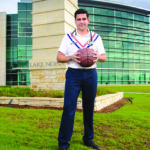
As you may know, a cataract is the clouding of the natural lens in the eye and is most commonly associated with aging. Other risk factors such as smoking, diabetes and steroid use can accelerate cataract formation.
Cataracts affect almost 22 million Americans age 40 and over. By age 80, more than half of all Americans will have cataracts, according to the National Eye Institute. More than 90 percent of those who have a cataract will regain useful vision after treatment. Cataract surgery is generally a very successful surgery, however there are important facets of the process from the time of diagnosis to that of surgery and thereafter that need to be understood to maximize one’s visual outcome after surgery.
Detailed Preoperative Testing
After one is diagnosed with a visually significant cataract, a patient should be thoroughly examined during a preoperative examination. The main purpose of this visit is to perform extensive diagnostic tests to confirm and measure the length of the eye and the curvature of the cornea in order to determine the exact power of the intraocular lens (IOL) that will be implanted at the time of surgery. The type of IOL implanted, especially premium lens implants, depends on advanced metrics such as corneal astigmatism, spherical aberration, angle kappa, and angle alpha.
These technical measurements quantify how and where light focuses within the eye and with respect to the central line of sight and the prospective lens implant. Focusing on these measurements can significantly improve the quality of vision post-operatively. Furthermore, clinical issues need to be addressed prior to surgery, such as the presence and/or severity of dry eyes, glaucoma, and retinal disease such as macular degeneration and diabetic retinopathy. Clinically active eye diseases should be stabilized prior to proceeding to cataract surgery.
Lastly, your surgeon should check for potential pitfalls during surgery such as poor pupil dilation, patients taking medications such as Flomax, patients with a history of refractive surgery, and patients with a history of eye trauma. Based on your medical history, eye history, and detailed measurements, your ophthalmologist should suggest lens implants and surgical options that will maximize your vision post-operatively.
Cataract Surgery
During surgery, small incision, no-stitch cataract surgery is the mainstay technique in treating cataracts. Small, sub-2.5 millimeter incisions are made into the clear part of the eye, called the cornea.
During the procedure, your ophthalmologist will remove the natural lens in your eye that has become cloudy (cataract) by way of these small incisions and ultrasound power. Your surgeon will then implant an artificial lens (IOL) to focus light onto the retina just like the previously removed, natural lens did.
Two technologies that assist in maximizing visual potential during cataract surgery are Femto-second Laser Assisted Cataract Surgery (FLACS) and Optiwave Refractive Analysis (ORA).
In FLACS, the laser is used in conjunction with an image-guided computer program that allows the surgeon to be more precise and helps to tailor each patient’s treatment to their particular needs as well as the preferences of the surgeon. The surgeon is able to fully customize each surgical procedure to the specific needs of the patient. FLACS will create incisions in the cornea, open up the capsule where the lens is located, and break up the cloudy lens much more accurately than what could be done by hand.
ORA technology is a sophisticated device used to provide real-time surgical measurements of the patient’s eye after the cataract (cloudy lens) is removed so the correct power of the IOL can be determined based on a desired outcome and may be adjusted, if necessary. This technology provides the highest level of customization available, better visual outcomes, and reduces the need for follow-up procedures.
Post-Operative Steps
Once your cataract is removed, it’s important to be patient and let the eye heal. Most patients are able to see very well within three to seven days after cataract surgery. The first few days are normally blurry because of dilated pupils and post-surgical inflammation that is part of the healing process.
To hasten recovery, it is important to follow the surgeon’s post-operative instructions in regards to eye drops and activity. Most patients will need to use prescription eye drops to reduce the risk of an infection and reduce inflammation. These drops are typically used for several weeks. In terms of activity level, most patients are restricted from heavy lifting, bending and straining for one week and water activities for at least one month.
Over the last five years, I’ve had the privilege of providing advanced cataract surgery to Lake Nona. I understand that undergoing cataract surgery can certainly make one anxious and nervous. However, know that technology has improved by leaps and bounds over the past few decades and even over the past five years! In the end, it’s important to enjoy the process and understand your expectations and options as you regain youthful vision.


